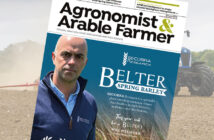Defra’s latest discussion document, outlining how the Environmental Land Management System (ELMS) might operate, suggests that government is listening to farmers, writes Jason Beedell, Strutt & Parker rural research director
The clearest picture yet of what the new Environmental Land Management System (ELMS) might look like emerged in February 2020 when Defra published its Environmental Land Management Policy Discussion Document.
It is the system which will be the cornerstone of agricultural policy for English farmers once Basic Payments are fully phased out in 2028, assuming that the current coronavirus crisis does not change the timetable for the implementation of the Agriculture Bill.
What is encouraging for farmers is this is one of the best documents we can remember Defra publishing.
It is not very often that we congratulate Defra, but it deserves it on this document and on its current thinking on ELMS. The paper is open, honest and constructive, and most importantly encouraging for land managers.
It shows that Defra has been listening to suggestions from farming and environmental bodies, and it feels like ELMS could be environmentally effective and be clearer and more practical than existing schemes for land managers. This will be crucial if Defra is to build confidence among farmers.
The paper acknowledges past mistakes and the need for engagement with the farming sector. It says that Defra wants to ‘move away from a subsidy-based approach to a more business-like partnership’, which feels like a good start to that change in the relationship between government and land managers.
So what are the key points?
The document says that Defra is considering a three-tier structure for ELMS – a basic tier for actions that all land managers can do, with more complex specialist or local work in tiers 2 and 3.
Tier 1 will be the entry level and Defra says that all farmers will be eligible to join. It will make payments for environmentally-sustainable farming and forestry actions that the majority of farmers can do. Payments are likely to be based on income forgone and costs incurred, but adjusted over time in response to supply and demand to achieve the desired level of uptake.
Tier 2 will be similar to the current Countryside Stewardship Scheme which all farmers will be eligible for, but it is most likely to be taken up by those with more interest and experience. Payments are initially expected to be based on actions – so again the familiar income forgone and costs incurred model – with top-up payments based on results. However, long-term payments could be results-based for certain outputs.
The final tier (3) will be for large-scale projects such as forest and woodland creation or peatland restoration and may be by invitation only, with payment rates negotiated on an individual basis.
While the guidance on the three-tier framework is welcome, what is perhaps most encouraging is that Defra seems willing to learn from the lessons of previous agri-environment schemes.
When it comes to designing the scheme, it wants to make the objectives clear to farmers as previous schemes have been most effective when they have had clear targets or objectives that can clearly be understood.
Very positively – given this is a common complaint about the current CSS – it says that it will try to avoid being overly prescriptive about how land managers deliver actions on the ground.
It also acknowledges that compliance requirements under previous schemes have been overly complex and demanding which has reduced farmers’ willingness to sign up in the first place. As such, it has promised that it wants to introduce ‘sensible’ reporting requirements and a proportionate approach to instances where farmers are found to be in breach of the rules.
And while we are still some way from knowing the level of payments for different management options, there are clear signs that the payment methodologies will be more flexible than they have been in the past – an acknowledgement that if payments aren’t attractive enough the scheme will be undersubscribed.
Of course, there are elements of the paper which do raise questions. For example, under the Tier 2 there is the suggestion that it might be available on land adjacent to towns and cities (peri-urban) which has not been previously targeted by agri-environment schemes.
This will be a concern for many farmers who will see it spreading funding over a wider area, making it harder to fill the financial gap created by the loss of BPS. Many farmers will be hoping that payments under ELMS will make up most of the fall in BPS, but this will already be a challenge for arable growers given we expect to see a movement of agri-environment scheme payments from the lowlands to the uplands to pay for public goods such as afforestation and management of peatlands.
- Defra is inviting people to feedback on its ELMS document by 5th May 2020.
- It will also want land managers to sign up early to the National Pilot of ELMS, which will start in 2021. To get involved, contact elmfeedback@defra.gov.uk .




